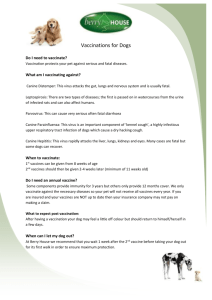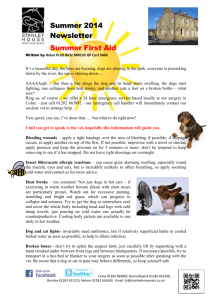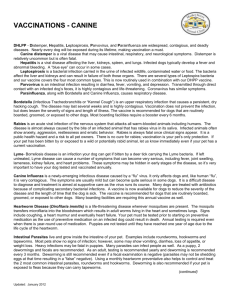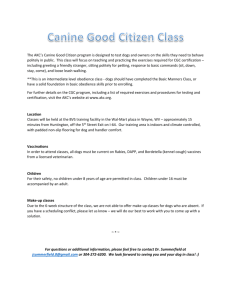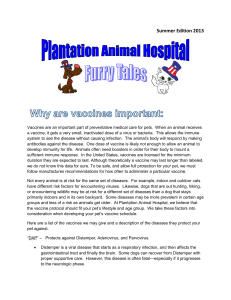Canine Vaccination Guidelines 2011
advertisement
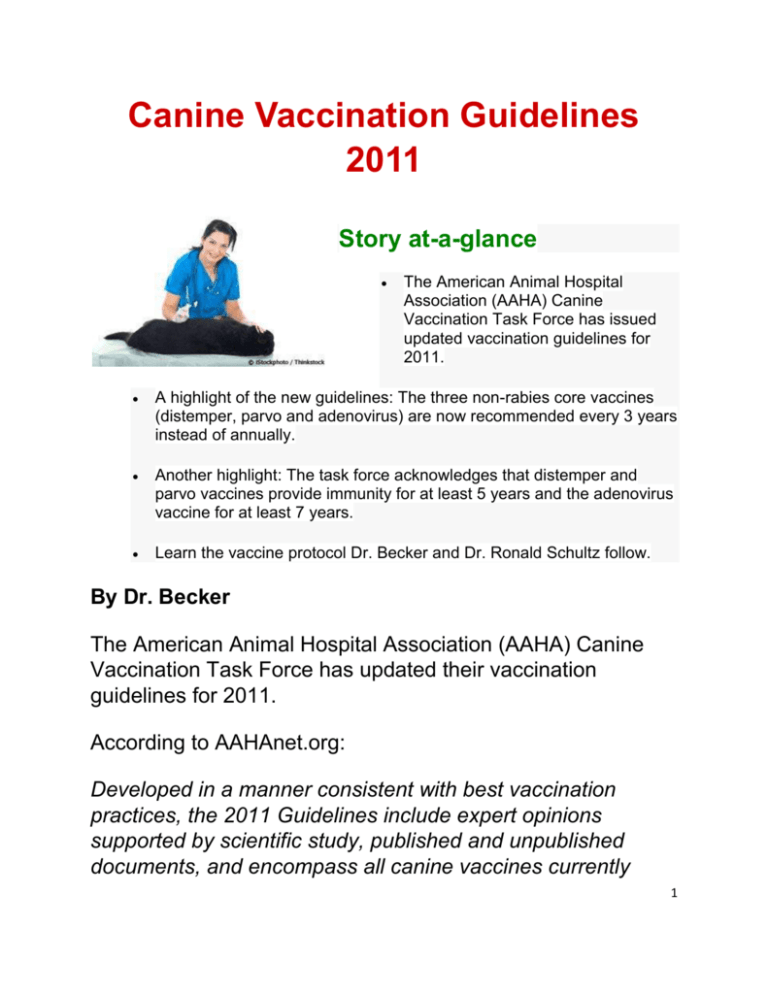
Canine Vaccination Guidelines 2011 Story at-a-glance The American Animal Hospital Association (AAHA) Canine Vaccination Task Force has issued updated vaccination guidelines for 2011. A highlight of the new guidelines: The three non-rabies core vaccines (distemper, parvo and adenovirus) are now recommended every 3 years instead of annually. Another highlight: The task force acknowledges that distemper and parvo vaccines provide immunity for at least 5 years and the adenovirus vaccine for at least 7 years. Learn the vaccine protocol Dr. Becker and Dr. Ronald Schultz follow. By Dr. Becker The American Animal Hospital Association (AAHA) Canine Vaccination Task Force has updated their vaccination guidelines for 2011. According to AAHAnet.org: Developed in a manner consistent with best vaccination practices, the 2011 Guidelines include expert opinions supported by scientific study, published and unpublished documents, and encompass all canine vaccines currently 1 licensed in the U.S. and Canada. The task force that developed the guidelines included experts in immunology, infectious diseases, internal medicine, law, and clinical practice. I'm encouraged by, if not blissful about the new guidelines. The absolute highlight is that all core vaccines with the exception of the 1-year rabies are now recommended at 3year or greater intervals. Even more exciting is the task force has acknowledged that in the case of the non-rabies core vaccines,immunity lasts at least 5 years for distemper and parvo, and at least 7 years for adenovirus. Hopefully these new guidelines will help more dog owners understand the long-lasting effect of those puppy shots! And hopefully, more dog owners will now request titers rather than automatically revaccinating their canine companions for distemper, parvo and adenovirus. Summary of New AAHA Canine Vaccination Guidelines for 2011 Please note: My vaccine recommendations and those of Dr. Ronald Schultz, follow this summary. 2 CORE VACCINES Canine Distemper (CDV) Initial vaccination in puppies less than 16 weeks of age Starting at 6 weeks, vaccinate every 3 to 4 weeks (6, 10, 14 or 8, 12, 16 weeks) up to 14 or 16 weeks; final shot should be given between 14 and 16 weeks to minimize risk of maternal antibody interference Initial vaccination in dogs greater than 16 weeks of age One dose Revaccination For puppies who received initial vaccination series by 16 weeks, a booster no later than 1 year after completion of initial series, then ≥ 3 years thereafter For dogs who received initial vaccination after 16 weeks of age, every ≥ 3 years thereafter Notes: Among healthy dogs, distemper vaccines are expected to induce immunity for at least 5 years. Canine Parvo (CPV-2) Initial vaccination in puppies less than 16 weeks of age 3 Starting at 6 weeks, vaccinate every 3 to 4 weeks (6, 10, 14 or 8, 12, 16 weeks) up to 14 or 16 weeks; final shot should be given between 14 and 16 weeks to minimize risk of maternal antibody interference Initial vaccination in dogs greater than 16 weeks of age One dose Revaccination For puppies who received initial vaccination series by 16 weeks, a booster no later than 1 year after completion of initial series, then ≥ 3 years thereafter For dogs who received initial vaccination after 16 weeks of age, every ≥ 3 years thereafter Notes: Among healthy dogs, distemper vaccines are expected to induce immunity for at least 5 years. Canine Adenovirus (CAV-2) Initial vaccination in puppies less than16 weeks of age Starting at 6 weeks, vaccinate every 3 to 4 weeks (6, 10, 14 or 8, 12, 16 weeks) up to 14 or 16 weeks; final shot should be given between 14 and 16 weeks to minimize risk of maternal antibody interference 4 Initial vaccination in dogs greater than 16 weeks of age One dose Revaccination For puppies who received initial vaccination series by 16 weeks, a booster no later than 1 year after completion of initial series, then ≥ 3 years thereafter For dogs who received initial vaccination after 16 weeks of age, every ≥ 3 years thereafter Notes: Among healthy dogs, distemper vaccines are expected to induce immunity for at least 7 years. Rabies 1-year Initial vaccination in puppies less than 16 weeks of age One dose not earlier than 12 weeks or as required by law Initial vaccination in dogs greater than 16 weeks of age One dose Revaccination For all dogs: annually as required by law Rabies 3-year 5 Initial vaccination in puppies less than16 weeks of age One dose not earlier than 12 weeks or as required by law Initial vaccination in dogs greater than 16 weeks of age One dose Revaccination For all dogs: within 1 year of initial dose regardless of age at time of initial dose, then every 3 years thereafter as required by law NON-CORE VACCINES Measles Vaccine (MV) This vaccine is supposed to provide temporary immunization of young puppies against distemper by 'cross-protecting' them against the disease in the event there are still maternally derived antibodies present. It is always given in combination with other vaccines – distemper plus measles, or a 4-way combination of distemper plus measles plus adenovirus plus parainfluenza. It is only recommended for healthy dogs between 6 and 12 weeks of age. Canine Parainfluenza (CPiV) 6 There are two delivery systems for this vaccine – intranasal and parenteral (injected). This is a flu vaccine. The intranasal form prevents clinical signs of illness, infection and shedding. The injected form prevents clinical illness, but not infection or shedding. It is used for dogs that aggressively resist intranasal delivery. The parenteral vaccine is always given in combination with certain core vaccines; the intranasal form is always given in combination with the bordetella vaccine alone, or with bordetella plus adenovirus. It is always given in a single dose. Revaccination recommendations, depending on the form of the vaccine (intranasal or parenteral), are per the combined core vaccine schedule, annually, or more frequently for 'high risk' animals. Bordetella (Bb) Vaccine The bordetella vaccine can also be delivered intranasally or by injection. Parenteral administration requires two doses, 2 to 4 weeks apart. For the initial vaccination, it is recommended the second dose be given at least a week before the dog is boarded, attends a dog show, etc. Revaccination is recommended annually The intranasal vaccine is single dose, with revaccination recommended annually or more often for 'high risk' dogs. Some dogs experience side effects for 3 to 10 days after 7 vaccination, including coughing, sneezing and nasal discharge. Canine Adenovirus (CAV-2) – Intranasal The intranasal form of the adenovirus vaccine is a non-core vaccine. It's recommended for dogs at risk for respiratory infection caused by the adenovirus, and it may not provide immunity against canine hepatitis. It should not be considered a replacement for the injectable form of the vaccine. This vaccine is available only in combination with the intranasal bordetella and parainfluenza vaccines. Canine Influenza Vaccine is given in two doses, 2 to 4 weeks apart, in dogs older than 6 weeks. Annual revaccination is recommended. Borrelia burgdorferi (Lyme disease) Vaccine is given in two doses, 2 to 4 weeks apart, in dogs older than 12 weeks of age. Revaccination is recommended annually and/or at the beginning of tick season as determined regionally. Notes: Recommended only for use in dogs with known risk of exposure, living in or visiting regions where exposure risk is high or where Lyme disease is endemic. Tick control products are required in addition to the vaccine. 8 Leptospira interrogans This refers to the 4-way killed whole cell or subunit bacterin. The 2-way killed bacterin form of this vaccine is not recommended. Vaccine is given in two doses, 2 to 4 weeks apart, in dogs older than 12 weeks of age. Revaccination is recommended annually, but only for dogs with reasonable risk of exposure. Notes: Vaccination should be based on known geographic occurrence/prevalence and exposure risk of the individual dog. Canine Oral Melanoma This vaccine is only available for treatment of dogs with malignant melanoma. It is not intended for the prevention of oral melanoma. Crotalus atrox (Western Diamondback rattlesnake vaccine) (toxoid) Field efficacy and experimental challenge data in dogs are not available at this time. (Vaccine efficacy and dose recommendations are based on toxin neutralization studies conducted in mice.) 9 Canine Coronavirus (CCov) This vaccine is not recommended. Neither the modified live nor the killed CCov vaccine has proved effective against combination coronavirus/parvo disease. Only the parvo vaccine is protective against dual viruses. What Dr. Ron Schultz Recommends For those of you not familiar with Dr. Schultz, I recommend you watch my 4-part video series with him. You can find links to all 4 videos and articles here. Dr. Schultz is one of the preeminent experts in the field of veterinary vaccines. If you read the full AAHA vaccination guidelines report, you'll see his work referenced throughout. Dr. Schultz recommends not starting a puppy or kitten core vaccination program before 6 to 8 weeks of age, with revaccinations no more frequent than every 4 weeks. So for example, if you start the program at 8 weeks, you would give another dose of the core vaccines at 12 weeks, and the third dose at 16 weeks. Dr. Schultz's core vaccine protocol for his own family's pets differs in that he actually runs antibody titers on the mother to know exactly when the best time is to effectively immunize the puppy or kitten for the 3 core viruses. Then he titers the little ones 2 or more weeks after the 10 vaccine, and as long as the response is adequate, he doesn't in most cases revaccinate for the rest of the pet's life. When it comes to rabies vaccines, Dr. Schultz gives the first vaccine after 4 months of age, revaccinates in a year, and then again in 3 years and every 3 years thereafter. In other words, he follows the law for 3-year rabies vaccines, even though he doesn't believe a vaccination every 3 years is necessary for immunization. Currently Dr. Schultz is in year 4 of a 7-year study of the rabies vaccine. You can read more about the study at the Rabies Challenge Fund. His goal is to be able to recommend that after an animal is vaccinated at from 12 to 24 weeks for rabies, there's no need for re-vaccination every 3 years. Hopefully we'll see the results of his 7-year study reflected in a future revision of the AAHA's canine vaccination guidelines, as well as in state and local laws. My Vaccination Protocol My protocol at Natural Pet is a first round of the 3 cores before 12 weeks of age, usually around 9 to 10 weeks. Then I boost between 15 and 16 weeks. Then I titer 2 weeks after the second round to see if the animal has been immunized and not just vaccinated. 11 My rabies protocol mirrors Dr. Schultz's, except I prefer to wait until 6 months of age before giving rabies vaccine. As for the non-core vaccines, I don't recommend any of them. Visit the following pages for a discussion of: Canine flu vaccines (PG 13) Bordetella vaccine (PG 19) SEE ARTICLES BELOW Lyme disease vaccine (PG 24) Leptospirosis (PG 31) Note several non-core vaccines are only available in combination with other vaccines, some of which are core. I recommend you check with your vet to ensure none of the non-core vaccines are being piggy-backed on core vaccines your pet receives. Most traditional vets do not carry single vaccines, so ask to see the vaccine vial before assuming your pet is only receiving one agent at a time. Source: Veterinary Practice News September 26, 2011 Source: AAHAnet.org Related Links: Why Re-Vaccination is the WORST Reason for Routine Vet Visits… 12 How Often Should You Vaccinate Your Cat or Dog? How Much Money are You Wasting on Pet Vaccines? What are the Dangers of Mutating Pet Flu Viruses, and Does Your Pet Need a Flu Shot? Visit the Pet Video Library On October 20, Fox News reported that dog flu, also known as H3N8, or CIV for Canine Influenza Virus, could be added to the list of illnesses to think about if you’re a dog owner. CIV is reportedly a mutated form of Equine Influenza, or horse flu, and was first discovered about three years ago. CIV is thought to be mild in most cases with a mortality rate from 1-5 percent. It has already been identified in 30 different states including Florida. Vets warn it can be tough to identify because its symptoms mimic other canine illnesses like kennel cough. Altamonte Springs, FL veterinarian Dr. Roger Hart says the symptoms can include: runny nose, weepy eyes, cough, bronchitis and even pneumonia. Dr. Becker's Comments: 13 Canine influenza virus (CIV) is a new virus that has been recently identified as a part of the canine infectious respiratory disease complex, otherwise known as kennel cough. “Kennel cough” is a collection of viruses that cause upper respiratory disease in dogs. This new virus is causing a bit of a scare, similar to that of the human H1N1, swine flu virus. Hopefully, this information will put your worst fears at ease. What is This New Canine Influenza? All viruses are categorized by their surface protein, of which there are two: “H” and “N.” The canine virus is categorized as H3N8. Interestingly, the H3N8 virus is also the categorization for the equine (horse) influenza virus, which has been in the US for over 40 years. Epidemiologists knew dogs could acquire this virus from horses, but veterinarians also know the flu virus is very adaptable to change, which is what happened in this situation. In this case, the equine virus mutated, and is now capable of being transmitted from dog to dog, without an equine host. It’s worth noting that CIV has no correlation with any of the human viruses, including the avian flu, or the swine flu. There have been no documented cases of dogs acquiring the swine flu virus. 14 Contributing Factors that Promote Spreading of Canine Influenza Two major factors have been identified that can contribute to animals breaking with this infection: 1. Overcrowding, such as dog kennels, shelters, and racing facilities 2. Stress, which suppresses your dog’s immune system Racing greyhounds, for example, experience very stressful conditions, but there are many situations that can cause your dog to experience stress, and environmental factors such as toxins also play an important role. Signs and Symptoms of Canine Influenza The symptoms of CIV are quite similar to that of the human flu virus, including: Cough Runny nose Lethargy Fever The incubation period for the H3N8 virus is two to four days, at which point you’ll notice upper respiratory symptoms. The symptoms typically last for about 7 days, during which time your dog is infectious. 15 Naturally, you’ll want to avoid him mingling with other dogs during this time in order to not spread the infection. If your dog’s symptoms are progressively getting worse, you’ll want to take your dog to a veterinarian – ideally a holistic veterinarian, who has access to a whole arsenal of natural treatments that can help. To find an integrative vet in your area, visit www.ahvma.org. Most dogs, however, will not need medical treatment. The viral infection is temporary, and under normal circumstances your dog’s immune system will be quite capable of overcoming the virus naturally. How to Boost Your Dog’s Immune System Regardless of the type of infectious disease, there are strategies you can use to help bolster your dog’s natural defenses, including: Feed your dog a balanced, raw food, species appropriate diet. Remember that a balanced diet needs to include adequate amounts of trace minerals, antioxidants and fatty acids Reduce stress by reducing your dog’s environmental toxin load These common sense strategies will help your dog's immune system remain strong and resilient. While there is much talk about toxins wreaking havoc with human health, many forget that animals, both domestic and 16 wild, are equally at risk from environmental poisons, which increases their toxic burden and creates biological stress. To help reduce your pet’s environmental toxin load, make sure your dog has access to pure drinking water and optimal air quality. As you may already know, indoor air quality is typically far worse than outdoors, so you may want to invest in a good indoor air purifier, both for your own health as well as your pet’s. You’ll also want to avoid as many chemicals as possible. This includes chemicals sprayed around your house, such as herbicides, pesticides and insecticides, as well as those applied directly to your pet, such as flea and tick medications. Last, but certainly not least, you’ll want to limit the amount of vaccines you give to your dog. Vaccines are metabolic stressors that can distract your pet’s immune system, and actually open them up to infectious It’s important to realize that dogs do not require annual vaccinations. For more in-depth information about vaccinations, please see my previous article, When it Comes to Vaccinating Your Pet, Less is More. What About the CIV Vaccine? I recommend NOT vaccinating against CIV, since most house pets will not be in situations that warrant the use of the vaccine, such as in overcrowded boarding facilities, race tracks, or pet shelters. 17 Worse yet, some uneducated people are asking their vets to administer the CIV vaccine to prevent the human H1N1 flu, and some vets are more than willing to comply, taking advantage of their ignorance. However, these two strains are completely unrelated and one vaccine will not protect against the other. Remember, dogs do not acquire swine flu. Remember, in the vast majority of cases, dogs recover uneventfully from their “dog flu” on their own. Only rarely is hospitalization needed -- usually only for very young puppies or immuno-suppressed animals, such as older, debilitated or immensely stressed animals. If you have cause to believe that your dog has been exposed to the CIV virus, your veterinarian can do a PCR nasal swab, or take paired serum samples to confirm this diagnosis, but in the vast majority of cases you don’t need to do either, unless you can clearly see that your dog is unraveling from potential infection. If your dog has been exposed I do recommend, however, considering the common sense strategies like adding turmeric, oregano, and fresh garlic to your dog’s diet, which all boost natural immune defenses. Discuss appropriate doses for your dog’s age and current immune status with your integrative veterinarian. You can also use adaptogenic herbs, such as ashwagandha, tulsi, bach flower essences, or essential oil of lavender, which can help limit the amount of immune suppression that might occur when your pet is exposed to intermittent stressors. 18 Your best bet is to help your dog develop a functional immune system through adequate diet and stress reduction. Why This Vaccine (Bordatella) is WORTHLESS and Won't Stop Your Dog Getting the Disease... If your dog seems to be coughing a lot or making choking sounds, he may have a case of canine infectious tracheobronchitis, more commonly known as kennel cough. Believe it or not, as awful as the choking, hacking noises sound, most episodes of kennel cough are not serious and resolve without treatment. Dr. Becker's Comments: Kennel cough has a number of different causes, only one of which — the most common cause — is the Bordetella bronchiseptica bacteria. Many people think bordetella is kennel cough, but that is technically inaccurate. 19 In fact, dogs that acquire the bordetella bacteria usually have a virus that makes them more vulnerable to infection. Some of these viruses are the canine adenovirus, distemper, canine herpes, and the parainfluenza virus. Kennel cough is a form of bronchitis and is similar to a chest cold in humans. How Dogs Get Kennel Cough Kennel cough is contagious, so whether your dog has the illness or you know of dogs that do, make sure to keep them apart until they are well. Your dog comes down with kennel cough when she inhales bacteria or virus particles. The canine respiratory tract is coated in a protective lining of mucus, but if this lining is compromised, an infection can take hold from the inhaled particles. The result is inflammation of the larynx and trachea, and it’s the inflammation that causes the coughing reflex in your pup. The lining of the respiratory tract can be debilitated through exposure to cold temperatures; dust, cigarette smoke or other particles in the air; stressful situations like travel; and time spent in crowded conditions like those found in many animal shelters and boarding kennels. A weakened respiratory tract lining can’t provide your dog protection against inhaled infectious particles. 20 The universal symptom of a bordetella infection is a persistent, hard, “honking” cough. Your pup may gag or cough up foamy looking white phlegm. Occasionally a dog will have other signs of illness like a running nose, sneezing or a discharge from his eyes. Kennel cough rarely results in appetite loss or lethargy, so if your pup is showing those symptoms as well, there could be something else going on. Treatment for Kennel Cough Since most cases of kennel cough resolve without medical intervention, I don’t recommend immediate or automatic treatment with antibiotics or other medications. Allowing your pet’s body to heal itself naturally is always advisable. Complete recovery from a bordetella infection can take up to three weeks in healthy dogs, and twice as long in older pets or those with other underlying conditions. Occasionally, a serious episode of kennel cough can result in pneumonia. If your dog doesn’t start to improve on her own within a few weeks, make an appointment with your vet to be on the safe side. This advice also applies if your pup is having symptoms beyond what is seen with kennel cough, in particular any change in breathing patterns, appetite or energy level. During the acute phase of the illness, consider using a harness temporarily if your dog’s collar seems to be 21 aggravating the situation -- especially if she strains against her leash. You can also try humidifying the air she breathes to help reduce or alleviate coughing spells. About Vaccines for Kennel Cough Many veterinarians recommend bordetella vaccines – either by injection or nasal mist delivery. I’m not one of them, however. Many boarding kennels, doggie daycare facilities, groomers and other similar businesses require dogs be vaccinated for kennel cough. Please understand the reason behind this requirement – it is to remove liability from those establishments. The truth is, these vaccines are ineffective and will not prevent your dog from getting kennel cough. The infection is caused by a wide variety of bacterial and viral agents, and no single vaccine can provide protection from them all. Nor will the vaccines treat an active infection. On the rare occasion I provide a bordetella vaccine -- usually for a client who is leaving a dog at a facility that demands it -I always use the nose drop variety as it is much less toxic, doesn’t contain adjuvants, and has few if any side effects. And remember, your dog can still acquire the infection even if she’s been vaccinated. 22 If you must vaccinate your dog for some reason with the injectable kennel cough vaccine, consult a holistic veterinarian about detox agents and doses. Nine Safe Remedies for Kennel Cough 1. Nosodes. A nosode is a homeopathic remedy derived from a pathological specimen. Nosodes stimulate the natural immune system to react against specific diseases. Kennel cough nosodes are particularly effective. 2. Esberitox. This is a fast-acting Echinacea that I have found very effective in reducing the virulence of bordetella infections. 3. Vitamins C and E. Vitamin C is an antiviral and E provides immune system support. 4. Oregano oil has antiseptic, antifungal, antiviral and antibacterial properties. 5. Astragalus is an herb used in Chinese medicine to enhance the immune system, support lung function and stimulate the regeneration of bronchial cells. 6. Raw garlic and olive leaf are natural antibacterial and antiviral agents. 7. Raw honey will ease the discomfort of coughing, and certain herbs will soothe and naturally suppress a cough, among them licorice root and marshmallow. 23 8. Essential oils can be used to help a pup with kennel cough breathe easier. Oils of eucalyptus, lavender and tea tree have antibacterial and antiviral properties. Chamomile has a calming effect. 9. Slippery Elm can help soothe sore and irritated throats. As always, you should talk with your holistic veterinarian about natural remedies and the doses or applications most appropriate for your pet. Lyme Disease on the Rise For this article, dvm360 interviewed Susan E. Little, DVM. Dr. Little works in the Department of Veterinary Pathobiology, Center for Veterinary Health Sciences at Oklahoma State University. She is a past president of the American Association of Veterinary Parasitologists and an expert on veterinary and human parasites and tick-borne disease agents. According to Dr. Little, human cases of Lyme disease are increasing, 24 which means the number of infected dogs is also increasing (human cases are tracked, canine cases are not tracked in the same manner). Dr. Little says regions of the U.S. not previously endemic for Lyme disease also appear to be increasing. Human cases are coming from more counties and states than in the past. In recent years, more cases have been reported in the Great Lakes area and south along the East Coast all the way to North Carolina. However, the majority of cases remain in the Northeast and upper Midwest. Dr. Little would like veterinarians to maintain a heightened awareness that coinfection with other pathogens is common among dogs that test positive for Lyme disease. If an animal has one tick-borne disease, it very likely has others. In particular, any dog that doesn't respond to treatment for a single diagnosis should be checked for coinfection. Dr. Becker's Comments: I can personally vouch for the fact that Lyme disease is on the increase. Recently I've had an unusually high number of dogs test seropositive for Lyme antibodies at my clinic. Dogs testing positive have been exposed to the infection, but don't necessarily have the active form of the disease. The vast 25 majority (95 percent) of dogs exposed don't get sick or show any symptoms. In order to differentiate exposure from active disease, I run a quantitative C6 assay blood test from IDEXX Laboratories. Only dogs with active infection require treatment – the rest do not. Origins of Lyme Disease As Dr. Little points out, white-tailed deer and white-footed mice are the primary hosts and reservoirs for the infection that causes Lyme disease. Adult black-legged ticks, also called deer ticks and Ixodes ticks, thrive with plenty of deer around. The more deer there are in an area, the more deer ticks there will be. Younger ticks go after rodents like the white-footed mouse, but other small hosts like chipmunks and shrews are prevalent in certain regions. A tick transmits the Lyme organism, a spirochete, to a dog or a person and both can become infected. Lyme disease in cats and cattle is uncommon, but horses can become infected in tick-infested areas. Symptoms of Active Lyme Infection 26 In humans, signs of Lyme disease are a skin rash, which often resembles a bull's eye, and flu-like symptoms including fever and lethargy. Dogs not only don't develop a telltale rash, in most cases they don't even appear sick despite having contracted an acute Lyme infection. As Dr. Little mentions in the dvm360 interview, many dogs aren't seen by a vet until they develop arthritis or other symptoms of a long-term Lyme infection. Typically we see an otherwise healthy dog that has recently developed polyarthritis, which may or may not move from leg to leg – and there's no explanation for the sudden lameness. Other symptoms can include: Fever Lethargy Malaise Shifting joint pain That's why I do the C6 test whenever I have a patient testing positive for Lyme antibodies. The C6 test helps me determine whether there's active infection so I can institute treatment with the antibiotic doxycycline if necessary. Keep in mind only 5 percent of dogs with Lyme antibodies actually become sick with the above symptoms. In an even smaller percentage of pets, chronic Lyme disease can result 27 in significant kidney problems, as well as autoimmune polyarthritis, a type of joint degeneration secondary to an undiagnosed, untreated Lyme infection. Testing for Coinfections As Dr. Little points out, many dogs with active Lyme infection also have other infections. If your dog is diagnosed with active Lyme disease, your vet should run another IDEXX test, the SNAP-4Dx blood test. The SNAP-4Dx tests not only for Lyme, but also for heartworm disease, anaplasmosis, and e. canis, and is beneficial in both diagnosis and treatment. I also recommend checking for Rocky Mountain Spotted Fever if you are in an endemic area. Ineffective, Toxic Parasite Preventives I'm not a proponent of Lyme disease vaccines. These vaccines are bactrins, created to treat non-viral infections. Their immunization duration is short, usually around a year. Even worse, these vaccines are known to be significantly more reactive to the immune system. Sending your pet's immune system into hyper-drive can trigger a whole host of serious secondary reactions, including autoimmune disease. Further, many dog owners mistakenly believe the vaccine will somehow prevent ticks from attaching to their pet. This isn't true – you still need a tick repellent. 28 If you live in a Lyme endemic area and use a chemical tick repellent on your pet, using the vaccine as well will give your pup a double dose of toxins and increase his risk of toxicosis, a disease resulting from poisoning. Just a few weeks ago I saw my first canine patient with Lyme disease and heartworm disease -- conditions she acquired while taking a monthly, year-round chemical heartworm preventive and a spot-on flea/tick preventive prescribed by her regular vet. This poor dog's situation is a good demonstration of the ineffectiveness of some of these drugs. It's also another warning signparasites are growing resistant to the drugs used to prevent and eradicate them, thanks in large part to overprescribing and overuse. As I write this, veterinary drug companies are scrambling to develop the next generation of toxic chemicals that will cause more autoimmune disease and cancer in too many precious animals. And without question, pests will grow resistant to these newer, more deadly drugs as well. Safe Ways to Prevent Lyme Disease in Your Canine Companion In the spring, summer and fall, avoid tick-infested areas. If you live where Lyme disease is endemic or you inadvertently wind up in a tick-infested area, check your pup for ticks twice each day. Look over his entire body, 29 including hidden crevices like those in the ear, underneath his collar, in the webs of his feet, and underneath his tail. If you find a tick, make sure to remove it safely. Use a safe tick repellent like Natural Flea and Tick Defense. If you live in a Lyme endemic region of the U.S., your veterinarian will probably recommend you use a chemical repellent. Remember: it’s important to investigate the risks and benefits of any medication before you give it to your pet. Create strong vitality and resilience in your dog by feeding a species-appropriate diet. Parasites are attracted to weaker animals. By enhancing your pet’s vitality, you can help her avoid the ill effects of a Lyme infection or other opportunistic pathogens. Source: dvm360 May 1, 2011 Related Links: Researchers Fear Spread of Canine Vector-Borne Diseases How Much Money are You Wasting on Pet Vaccines? Don't Fall for This Mistake with Your Pet's Pest Control... 30 A Dog Near Death and the Miracle of a Pet Owner's Love When Ann Krcik's 5-year-old Airedale terrier Shayla acquired leptospirosis, she was admitted to the Pet Emergency and Specialty Center of Marin in San Rafael, CA. Krcik asked the veterinarian, Dr. Marcella Harb-Hauser, if spending time with her dog at the center would help the healing process. Dr. Harb-Hauser encouraged Krcik to come visit her dog. The doctor believes that "Just like humans, if pets are less stressed, they heal faster." So Krcik visited Shayla several times each day, sitting on the floor with her 65 pound dog in her lap. Shayla seemed to be getting better, but additional tests showed the disease had attacked the dog's lungs and had become life-threatening. Dr. Harb-Hauser told Krcik there was nothing more she could do for Shayla medically. Krcik, sitting on the floor with Shayla in her lap, could feel her dog struggling to breathe. She held Shayla tighter, taking some small comfort in knowing at least she could hold her pet as she passed on. 31 At that very second, Shayla's health suddenly turned around. Her breathing improved and the very next day she was off oxygen and at home with Krcik to complete her recovery. According to Dr. Harb-Hauser: "We'll never really know why Shayla's health appeared to change in that instant. I firmly believe that Ann's presence, holding her the way she was, somehow helped Shayla enough to fight the physiological ailments she was facing. She may have recovered regardless, but it sure didn't seem that way." Dr. Becker's Comments: This wonderful story isn't really about leptospirosis, which I'll discuss shortly. It's about the human-animal bond and how truly life-giving we are to the pets who love us. If you want to be with your pet during vet exams, procedures and hospitalizations, you should make your wishes known to your veterinarian ahead of time, if possible. Some DVMs are perfectly fine having pet parents around while they work. Others don't feel comfortable with an audience. It will also depend on the procedure being performed, the size of the exam and procedure rooms, sterile field considerations, your stress level, your pet's, and other factors. 32 If your vet isn't willing to let you stay with your pet and the reasons he or she gives don't make sense to you, you might want to consider switching to another veterinary practice. And now I do want to discuss the disease that almost took Shayla's life, and two aspects of it in particular. One is the little-known fact that lepto can cause serious damage to the lungs and pulmonary function in dogs. And the other is, despite recent hype to the contrary, leptospirosis has been around a long, long time and is very successfully treated if caught early. Canine Leptospirosis Leptospirosis is caused by at least four species of leptospira bacteria (serovars) that infect dogs. We know that there are more than 20 serovars in existence. Leptospira are found in both domesticated and wild animals, with rats, pigs, raccoons, cattle, skunks and opossums as the main reservoirs of infection. With suburban sprawl, more family dogs are coming in contact with wildlife, and this could be the cause of the increase in lepto cases. The bacteria is spread in urine. It gets into water sources and can remain infective in soil for as long as six months. Dogs can pick up the bacteria through a cut or other break in the skin or when they drink contaminated water. 33 Dogs at particular risk of acquiring the infection are those who spend a lot of time in the water, drink out of puddles, or who hang out in yards that get rain or snow runoff. Lepto Symptoms and Treatment Many leptospirosis infections are so mild there are no symptoms. Clinical signs will depend on the age and health of the dog, environmental factors affecting the bacteria, and the virulence of the infecting species. Young dogs tend to get sicker than adult dogs. If signs of infection do appear, they will show up from four to 12 days after exposure to the bacteria and can include: Fever and muscle pain Loss of appetite and vomiting Lethargy, depression Diarrhea Blood in the urine The disease primarily impacts the kidneys and liver. In serious cases, a dog can become jaundiced (usually the whites of the eyes turn yellow), indicating a case of hepatitis and destruction of liver cells. Blood clotting problems can develop which can cause blood in the stools and bleeding from the mouth. 34 An untreated dog who recovers from leptospirosis can become a carrier and shed the bacteria in urine for as long as a year. If your dog is seriously ill with the disease, she should be hospitalized both for her sake and for public health reasons. She'll be given an antibiotic or a combination of antibiotics, and she'll receive supportive care to alleviate vomiting and diarrhea, and to insure she's well hydrated and is receiving nutrition. If your dog has been diagnosed with lepto but doesn't require hospitalization, you can manage his care at home while implementing careful hygiene measures: Wear gloves in the event you need to come in contact with your pet's urine Wash your hands thoroughly after handling or cleaning up after your dog Clean non-porous surfaces that have been urinated on with either an antibacterial disinfectant or diluted bleach Leptospirosis is a zoonotic disease, which means it can be transmitted from animals to humans. It can cause flu-like symptoms in family members, and sometimes progresses to serious illness. If your dog has lepto and anyone in your family or others in contact with your dog get sick, be sure to mention the possibility of a leptospirosis infection to health care providers. 35 Leptospirosis and the Lungs Shayla, the 5-year-old Airedale terrier described above with lepto, was recovering normally until the disease hit her lungs. And while it's understood in veterinary medicine the disease sometimes affects the lungs of dogs, it is not a commonly seen situation and is much more prevalent in human leptospirosis than canine. That's why most available information on canine lepto doesn't even mention lung involvement. Lung involvement in humans with the disease is called leptospiral pulmonary hemorrhagic syndrome (LPHS). A study done in Berlin and published late last year in Veterinary Medicine International discusses a similar emerging syndrome in dogs. According to the study: Between 2006 and 2010, an increasing number of dogs suspicious for leptospirosis were treated at the Small Animal Clinic of the Freie Universität Berlin. More than two-third of these dogs had clinical and radiological pulmonary manifestation in addition to renal and hepatic insufficiency [20]. The cause of death in all 15 dogs in the study was severe, acute, pulmonary hemorrhage. And researchers theorized the acute liver and kidney lesions seen in some of the dogs were 36 most likely caused by hypoxia (oxygen deprivation) due to respiratory distress. The waters remain murky, however, because the cause of the pulmonary hemorrhage syndrome in the dogs could not be definitively linked to leptospiral organisms, even though all the dogs had the disease. In another Berlin study published around the same time but in the Journal of Veterinary Internal Medicine looked for pulmonary abnormalities in 50 dogs with leptospirosis. The study found that 35 of the 50 dogs had pulmonary changes according to x-rays, and 31 had pulmonary distress. Sixty-seven percent of the dogs (20 to 21) were euthanized because of respiratory distress. The study concluded 70 percent of dogs with leptospirosis had pulmonary changes, and that lung involvement as a symptom represents a severe complication that causes an increase in deaths from the disease. Preventing Leptospirosis Leptospira bacteria thrive in warm, humid climates and are frequently found in stagnant water, for example in ponds. Animals in the wild can also carry the bacteria. Dogs exposed to contaminated water and wild animals and their urine (hunting dogs, for example) are at greater risk than other dogs. 37 Infection is most prevalent in the summer and early fall, and after flooding. Rodent control around your home can cut down the opportunity for infection. And if you live in a location where lepto is common, keeping your dog away from ponds, slowmoving water and sitting or stagnant water will also reduce the risk. I actually live in a high-risk area for lepto, and I'm confident my dogs have had exposure (from our pond, or from all the free-standing water and puddles they drink from). In addition to keeping my pets' immune systems thriving, I also stay alert to the symptoms of lepto. A leptospirosis infection, like many bacterial infections, can be cured successfully if identified and treated early. If you live in an endemic area and your dog suddenly develops lethargy, a fever and symptoms of a urinary tract infection, ask your vet to test for lepto immediately. Quick diagnosis and treatment usually results in complete recovery from this bacterial infection. In fact, I treat about a dozen cases of lepto each year and have never had an animal experience any lasting consequences from the infection. There is a vaccine for leptospirosis, but I do not recommend it. It is a relatively weak bacterial vaccine with marginal staying power and it cannot protect against all 20 or more 38 leptospira serovars. The vaccine carries a significant risk of adverse reactions, especially in small dogs. Information is also emerging that the lepto vaccine can actually cause the disease in dogs, and can bring on kidney failure in older dogs. Source: Veterinary Practice News August 4, 2011 Source: Veterinary Medicine International. 2010; 2010: 928541. Published online 2010 December 27 Source: Journal of Veterinary Internal Medicine. 2010 Nov-Dec;24(6):1277-82 Related Links: Top 5 Diseases You Can Get from Your Pet… How Much Money are You Wasting on Pet Vaccines? Top 10 Pet-Owner Mistakes 39
